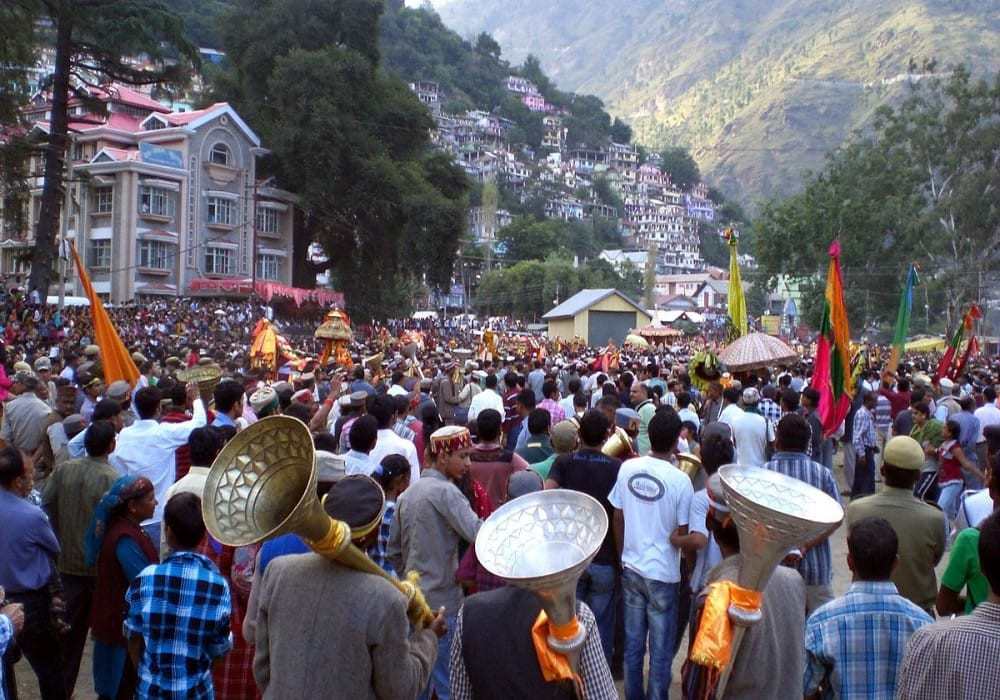
Last Updated At: 12-Mar-2024
10 Famous Temples In Manipur | You Must Visit In 2024
Embark on a spiritual journey through the enchanting state of Manipur and discover its rich religious heritage with our guide to the 10 famous temples. Nestled amidst the picturesque landscapes of
Manipur, these temples are not only revered for their architectural splendour but also for their cultural significance. From the historic Shree Govindajee Temple in Imphal to the serene Shree Bijoy Govindajee Temple in Thoubal, each temple holds its own unique charm and sanctity. Whether you seek divine blessings or simply wish to marvel at the intricate craftsmanship, these temples offer a sacred sanctuary for spiritual seekers and history enthusiasts alike.
List Of 10 Best Temples In Manipur
- Shree Govindaji Temple, Imphal | Preserving History and Devotion
- Radha-Krishna Chandra ISKCON Temple | A Touch of Transcendence
- Lord Krishna Temple |Weaving Spirituality into Tradition
- Shyamrai Temple | A Fusion of Cultures
- Jorebangla Temple | Where History Meets Spirituality
- Pancha Ratna Temple | A Quintet of Devotion
- Sridhara Temple | A Hidden Gem
- Hanuman and Mahabali Temple | Epitome of Devotion
- Hiyangthang Lairembi Temple | Reverence to the Goddess
- Sanamahi Temple | Embracing Ancestral Beliefs
1.Shree Govindaji Temple, Imphal | Preserving History and Devotion
Located in the heart of Imphal, the capital city of Manipur, the Shree Govindaji Temple is a significant religious and historical landmark. Built in the 18th century by Maharaja Raja Nara Singh. This ancient temple in Manipur is a splendid example of traditional Manipuri architecture. The intricate carvings, colourful frescoes, and elegant domes are a testament to the artistic prowess of the craftsmen of that era. Devotees flock to this temple to pray for Lord Krishna and seek blessings.
- Location: Wangkhei Keithel Ashangbi, Imphal East
- Timings: 5:30 AM to 1 PM; 4 PM to 8:30 PM
2. Radha-Krishna Chandra ISKCON Temple | A Touch of Transcendence
The International Society for Krishna Consciousness (ISKCON) has a presence even in the serene landscape of Manipur. The Radha-Krishna Chandra ISKCON Temple, located in Imphal, offers a spiritual haven for those seeking solace and enlightenment. The temple's serene ambience, enchanting kirtans (devotional songs), and the teachings of Lord Krishna imparted through the Bhagavad Gita attract visitors from all walks of life.
- Location: QWH6+Q95, Imphal, Ghari
- Timings: Open 24 hours
3. Lord Krishna Temple | Weaving Spirituality into Tradition
Lord Krishna's presence is palpable across Manipur, and the Lord Krishna Temple is another embodiment of the state's spiritual devotion. The temple complex exudes an aura of divinity, and the deity's idol is adorned with intricate jewellery and colourful garments. Devotees often participate in aarti (rituals of worship) with utmost reverence, creating an atmosphere of pure devotion.
- Location: Brahmpur Guru Aribam Leikai, Imphal
- Timings: 5 AM to 1 PM; 4 PM to 8:30 PM
4. Shyamrai Temple | A Fusion of Cultures
Shyamrai Temple in Imphal showcases the intermingling of Manipuri and Bengali architectural styles, exemplifying the essence of Manipur temple architecture. Dedicated to Lord Krishna, the temple's exquisite terracotta artwork narrates stories from Hindu mythology. The intricate detailing on the walls and pillars mesmerises visitors, making it a must-visit for those who appreciate architectural finesse.
- Location: Rajdarbar, Dalmadal Para, Bishnupur
- Timings: 9 AM to 5 PM
5. Jorebangla Temple | Where History Meets Spirituality
Jorebangla Temple, located in the heart of Imphal, embodies Manipur's historical and religious significance. Constructed during the reign of Maharaja Garibniwaz in the 18th century, the temple's unique architecture and ancient artefacts transport visitors to a bygone era. The serene courtyard and beautifully carved structures add to its allure.
- Location: Rajdarbar, Dalmadal Para, Bishnupur
- Timings: 7 AM to 7 PM
6. Pancha Ratna Temple | A Quintet of Devotion
Dedicated to Lord Vishnu, the Pancha Ratna Temple stands as a symbol of devotion and architectural brilliance. Its five shikharas (spires) rise elegantly against the sky, representing the five Pandava brothers of the Mahabharata. The tranquil surroundings and intricate sculptures of this hidden temple in Manipur offer a meditative experience for visitors.
- Location: Bishnupur, Manipur
- Timings: 6 AM to 6 PM
Read More : Famous Festival Of Manipur
7. Sridhara Temple | A Hidden Gem
Nestled amid the lush greenery of Manipur, the Sridhara Temple is a hidden gem that embodies simplicity and spirituality. The temple's serene atmosphere allows devotees to connect with the divine in a tranquil setting. The deity's serene expression and the temple's peaceful ambience make it a perfect place for introspection.
- Location: Bishnupur, Manipur
- Timings: Open 24 hours
8. Hanuman and Mahabali Temple | Epitome of Devotion
The Hanuman and Mahabali Temple, situated in Kangla Fort, Imphal, holds a special place in the hearts of the people of Manipur. The temple complex reverberates with the chants of Hanuman devotees and stands as a reminder of unwavering faith. The nearby Mahabali Temple adds to the spiritual significance of the site.
- Location: QWWV+97C, Wangkhei, Imphal
- Timings: 5 AM to 12 PM; 4 PM to 9 PM
9. Hiyangthang Lairembi Temple | Reverence to the Goddess
This temple, dedicated to Goddess Lairembi, is a testimony to Manipur's deep-rooted reverence for female deities. The intricate carvings and vibrant colours of this sacred temple in Manipur resonate with the spiritual energy of the goddess. The temple's unique architecture and spiritual significance make it a place of both cultural and religious importance.
- Location: PWG3+J73, Hiyangthang Mayai Leikai, Hiyangthang
- Timings: 5 AM to 12 PM; 4 PM to 9 PM
10. Sanamahi Temple | Embracing Ancestral Beliefs
Sanamahi Temple, dedicated to the deity Sanamahi, represents the indigenous beliefs of Manipur. As a centre of Meitei religious practises, the temple provides insights into the state's ancient traditions and cultural heritage. The temple's serene surroundings offer a peaceful space for introspection and connection with nature.
- Location: Q4PX+CV3, Jiribam
- Timings: 24 hours
Read more: Tourist Places To Visit In Manipur
Conclusion
As we conclude our exploration of Manipur's famous temples, we are left with a deep appreciation for the state's rich religious heritage. From the ancient rituals performed at Kangla Fort Temple to the serene ambience of Kaina Temple, each temple has left an indelible mark on our souls. As we bid farewell to these sacred sites, may the blessings and tranquillity experienced here continue to guide and inspire us on our spiritual journey.
Plan your trip with Adotrip today. Enjoy a wealth of information, end-to-end travel assistance and BOOK Flights, Hotels, and Tour Packages under one roof.
With us, nothing is far!
Book Manipur Tour Packages
Frequently Asked Questions About Temples In Manipur
Q1. Which are the most significant temples to visit in Manipur?
A1. Some of the most significant temples to visit in Manipur are the Shree Govindajee Temple in Imphal, Shri Bijoy Govindajee Temple, ISKCON Temple Imphal, Shri Radha Raseshwari Temple, and the Manipur State Museum.
Q2. Can I learn about the historical and religious importance of the temples?
A2. Certainly! The temples in Manipur hold historical and religious significance deeply intertwined with the state's cultural heritage. They often have stories of local deities, historical events, and spiritual practices associated with them.
Q3. Are the temples easily accessible by road or public transport?
A3. Yes, many of the temples in Manipur are accessible by road and public transport. However, it's advisable to check the specific location and transportation options before your visit.
Q4. Are photography and videography allowed inside the temples?
A4. Photography and videography policies can vary from temple to temple. Some may allow photography in certain areas while restricting it to more sacred spaces. It's best to enquire about the rules before taking any photos or videos.
Q5. What are the best times to visit the temples for festivals or special occasions?
A5. The best times to visit temples for festivals or special occasions vary based on the specific temple and the local calendar. Hindu festivals like Diwali, Holi, and Navaratri often see increased footfall at temples.
Q6. Are there any nearby attractions or cultural sites to explore along with the temples?
A6. Yes, many temples in Manipur are located near other cultural sites and attractions. You might find local markets, historical sites, and natural beauty spots nearby.
Q7. Can I find accommodations or guesthouses near the temples for overnight stays?
A7. Depending on the temple's location, you can often find accommodations or guesthouses nearby. However, it's a good idea to book in advance, especially during peak tourist seasons.
Q8. Are there any specific customs or rituals to observe while visiting the temples?
A8. While visiting temples, it's important to show respect by removing your shoes before entering, wearing modest clothing, and adhering to any specific rituals or customs that may be in place.
Q9. How do the temples represent the cultural heritage and traditions of Manipur?
A9. The temples in Manipur often showcase the blend of religious beliefs, cultural practises, and artistic traditions of the region. They are significant not only as places of worship but also as embodiments of local culture and heritage.
Q10. Are there any restrictions on entry for non-Hindu visitors at the temples?
A10. While certain temples may restrict non-Hindu visitors' access to inner sanctums, many are open to people of all faiths, welcoming them to enjoy the architecture and atmosphere. Checking temple policies beforehand is recommended.
--- Published By Adotrip
Latest Blogs

Long Weekends In India 2025 - List of Holidays

Kazakhstan Travel Guide 2025: Affordable Luxury, Visa Free E...

Think Ayodhya is Just Temples? Discover Its Hidden Artistic...

Why Azerbaijan is the Best Budget Friendly Alternative to Sw...









 Dubai
Dubai Malaysia
Malaysia USA
USA





